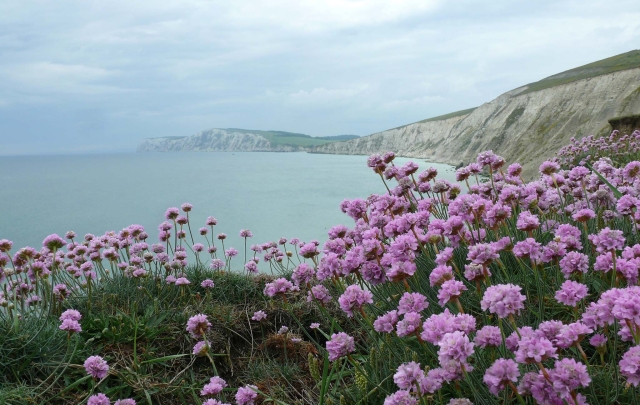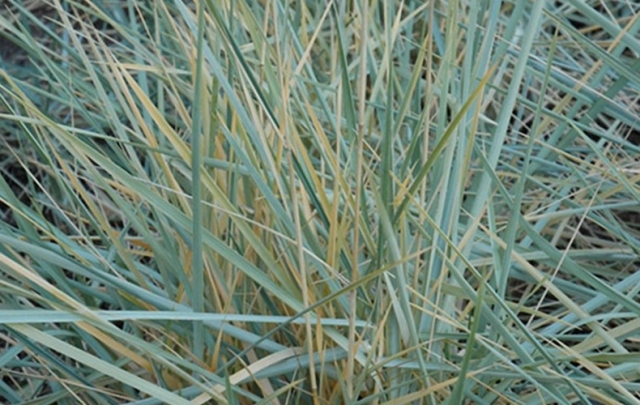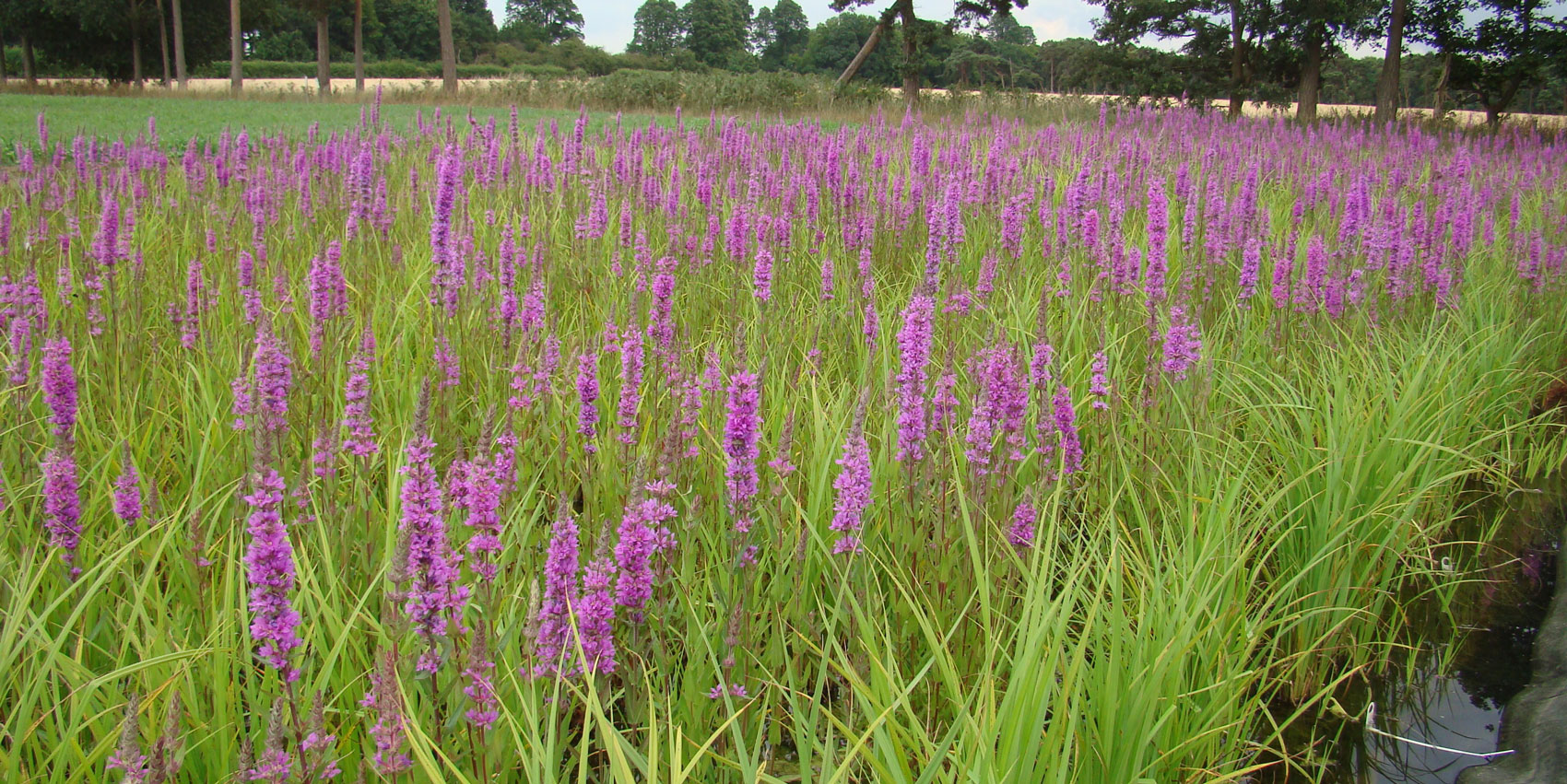Salix are the UK’s largest grower of native wetland and wildflowering plants in the UK
In response to demand for a wider range of species for specific habitat types we have developed a range of plug grown species for three key habitats: Salt marsh, Sand dunes & Moorlands.
There is more heather moorland in the Isles of Britain and Ireland than anywhere else in the world, but historical agricultural improvements, forestry and other land management activities have degraded many uplands, exposing peat and releasing huge amounts of carbon into the atmosphere.
These habitats can lock vast amounts of carbon away, act as a natural sponge to hold flood waters back in the uplands and are vital to many of the UK’s most enigmatic upland creatures. Large scale restoration of these habitats is underway throughout the UK and Salix are now growing a range of species to meet the demand of this restoration program.
With the soil of moorland and peatland habitat being acidic in nature, Salix grow their plants in ericaceous compost to ensure a healthy start.

Bog Moss
Salix stock and can contract grow the following Sphagnum (Bog-moss) species: Sphagnum capillifolium (Acute-leaved Bog-moss) Sphagnum cuspidatum (Feathery Bog-moss) Sphagnum denticulatum (Cow-horn Bog-moss) Sphagnum fallax (Flat-topped Bog-moss) Sphagnum fimbriatum (Fringed Bog-moss) Sphagnum inundatum (Lesser Cow-horn Bog-moss) Sphagnum magellanicum (Magellanic Bog-moss) Sphagnum palustre (Blunt-leaved Bog-moss) Sphagnum papillosum (Papillose Bog-moss) Sphagnum rubellum (Red Bog-moss) Sphagnum subnitens (Lustrous Bog-moss)

Calluna vulgaris (Heather)
The most widespread Heather across Britain. Dense, evergreen undershrub also known as Ling. Small bell-shaped flowers, usually pink in colour though occasionally cream/white. Calluna vulgaris is often the prevailing plant in heathland and moorland areas.

Eriophorum angustifolium (Common Cottongrass)
An upright perennial with distinct white cottony hairs when the plant is in fruit. Favours very boggy ground where peaty, acidic soil is present. Eriophorum angustifolium is a vigorous, rhizomatous plant forming clumps of dark green, linear leaves.

Eriophorum vaginatum (Hare’s-tail Cottongrass)
As with Eriophorum angustifolium, E. vaginatum is a perennial associated with moors and heaths on acidic soil. Smaller than Common Cottongrass with its fruits less striking. Hairs of the fruit are off white or cream in colour, and ruffled in texture.

Juncus articulatus (Jointed Rush)
Rush of moorland and damp heaths. A relatively small Rush growing to heights of 60cm. Fruits are brown, almost maroon, in colour and oval shaped.

Molinia caerulea (Purple Moor-grass)
As its name suggests, purple-green spikes form when in flower. An acid loving species found growing in damp ground on heaths and grassy moors

Vaccinium myrtillus (Bilberry)
Deciduous undershrub widespread across much of the region, though least common in the East of England. Favours the acidic soil of heathland.

Viola palustris (Marsh Violet)
Low growing perennial with creeping runners. Grows in bogs and marshes on acid soils. Flowers are lilac with striking, deep coloured veins.
Salt marshes not only protect our coastline from coastal erosion but also provide a declining and rare habitat that is a UK BAP Priority habitat.
Historical pressures to “reclaim” salt marsh for agriculture, coastal erosion and sea level rise are all historic and future threats to these habitats.
Salix now provide a range of salt marsh species to aid in the creation of new habitats and the protection of existing ones.
All our plants are grown to the highest of quality and come in plug sizes 65cc, 110cc and 230cc.
For contract grow orders and for plants that are more vigorous in growth, we offer our largest 370cc root trainer.

Armeria maritima (Sea Thrift)
A robust, low growing evergreen perennial that bears bright pink, cup-shaped flowers throughout summer. Also regularly found on cliff faces.

Aster tripolium (Sea Aster)
A taller salt-tolerant perennial reaching heights of up to 90cm and is found in saltmarshes, estuaries and sea cliffs. Leaves are narrow and fleshy, flowers are purple in colour and form similarly to that of a large daisy.

Juncus gerardii (Salt Marsh Rush)
A relatively small rush that may be hidden in the saltmarsh amongst larger plants such as Juncus maritimus. Common around the coastline of Britain and Ireland.

Plantago maritima (Sea Plantain)
Characteristic coastal perennial, tough and tolerant of salt spray. Low growing at around 15cm, flowers with yellow stamens in slender spikes.

Puccinellia distans (Reflexed Saltmarsh-grass)
A coastal grass, erect with spike-like flowers. Similar to Common Saltmarsh-grass but inflorescence branches reflexed in fruit.

Schoenoplectus tabernaemontani (Grey Club Rush)
A large rush growing to heights of up to 3m. Creeping, robust perennial tolerant of salt spray. Sends off runners from a thick, woody rhizome.

Silene uniflora (Sea Campion)
A low growing, cushion-forming perennial that is confined to sea cliffs and shingle beaches. White frilly, overlapping petals.
Sand dunes are dynamic coastal features that protect against coastal erosion and flooding, ranging from new pioneer dune slacks to mature dune systems that are thousands of years old.
Historical pressures of reclaiming sand dunes for agriculture, coastal erosion and sea level rise are all threats to these habitats.
Salix now provide a range of sand dune species to aid in the creation of new habitats and the restoration of existing ones.
Our sand dune plants are grown in a fibrous, coir based compost that creates the perfect free draining substrate required for these plants.

Ammophila arenaria (Marram)
A true native to the coastlines of Britain where it grows in the sands of beach dunes. Growing to 1m in height, this sand-specialist grass helps stabilise shifting sands by means of its underground stems. Ammophila arenaria colonises from a network of thick rhizomes which gives it anchorage in the sand substrate and allows it to spread outward. Its flowers form dense spikes and are straw-coloured. Leaves are grey-green, tough and rolled to help with loss of water.

Eryngium maritimum (Sea Holly)
Drought tolerant and absent from Northern Scotland. Found in shingle and sandy coastline habitats this bushy perennial has firm, spiky leaves with flowers blue-silver in colour.

Glaucium flavum (Yellow Horned Poppy)
A coastal poppy forming a distinct rosette of blue-grey leaves. Flowers with overlapping yellow petals.

Leymus arenarius (Lyme-grass)
Well adapted to highly salinized habitats, Leymus arenarius is a coastal specialist grass. Like Ammophila arenaria, Leymus arenarius grows on sandy beaches and in the sands of beach dunes. With large rhizomes the grass spreads and helps control soil erosion. It is marginally taller than A. arenaria growing to 1.5m. Its leaves however are similar, in that they are grey-green and rolled to reduce loss of water.
Salix are the largest grower of native wetland plants in the UK. Salix wetland nurseries have been designed and built specifically for commercially growing native wetland plants for supply throughout the UK.
Our wide range of wetland plants are both contract grown and used on our projects.
More information about our wetland nursery is available. and a full brochure can be downloaded of all our plants.

Our full Salt marsh, Sand dunes & Moorlands plug plant brochure can be downloaded.
We grow an supply a wide range of native plants, we have particularly specialised in wetland plants but can also supply a wide range of other native plants – download our Native plant brochure..
